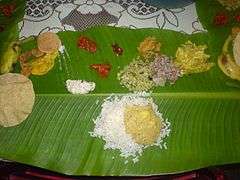Maithili New Year
| Maithili New Year | |
|---|---|
 A typical vishu food | |
| Observed by | Maithils |
| Type | Festival, Mithila, Bihar, India and Mithila, Madhesh, Nepal. |
| Significance | Maithili New Year |
| Celebrations | Feasting, gift-giving, visiting homes |
| Date | 1st Baisakh (14 April) |
| Frequency | annual |
Jude Sheetal (জুড়ি শীতল / जुड़ि शीतल) or Maithili New Year is the celebration of the first day of the Maithili new year. This day which usually falls on 14 April on Gregorian calendar is celebrated by the Maithils in Mithila region of India and Nepal. This is also called Nirayana Mesh Sankranti and Tirhuta new year. [1] The festive occasion is in keeping with the Maithil Panchang, a calendar used in whole of Mithila region.
On this day Satuani is also celebrated in Bihar.
Origin and significance
The Maithili New Year follows the Nirayanam vernal equinox and falls on 30 April (may sometimes vary by a day) on the Gregorian year. 14 April marks the first day of the traditional Vikram Samvat .
Tropical vernal equinox fall around 22 March, and adding 23 degrees of trepidation or oscillation to it, we get the Hindu sidereal or Nirayana Mesha Sankranti (Sun's transition into Nirayana Aries).[2]
Hence, the Maithili calendar begins on the same date, with Baishakh as first month of the year. It is also observed by most traditional calendars in India as in Tamil Nadu, Assam, Bengal, Kerala, Manipur, Orissa, Punjab, Tripura and also in Nepal. [3]
It is also the birthday of Raja Saltash. In every Mithila village there is 'Rajaji's gahwar,' which is worshiped mostly by Paswans but by all and hence, this day is symbolizing communal harmony.
Official significance
Maithili Calendar is the traditional Calendar of Mithila region of India and Nepal. After a long period of demand, Bihar government in 2011 declared this day as public holiday to be observed state wide. Officially, the Maithili New year day is called as Mithila Diwas by the Government of Bihar. Every year there will be holiday for Mithila Diwas on 14 April in the Indian State of Bihar on account of the great festival of Juir Sheetal.[4]
Related holidays in other cultures
It coincides with the New Years in many other Southern Asian calendars, including:
- Assamese New Year, or Rongali Bihu (India's Assam state)
- Odisha New Year, or Maha Vishuva Sankranti (India's Odisha state)
- Burmese New Year, or Thingyan (Burma)
- Khmer New Year, or Chol Chnam Thmey (Cambodia)
- Lao New Year, or Songkan / Pi Mai Lao (Laos)
- Nepali New Year, or Bikram Samwat / Vaishak Ek (Nepal)
- Sinhalese New Year, or Aluth Avurudda (Sri Lanka)
- Tamil New Year, or Puthandu (India's Tamil Nadu state and Sri Lanka)
- Thai New Year, or Songkran (Thailand)
- Tuluva New Year, or Bisu (India's Karnataka state)
- Bangladesh, Tripura and West Bengal it's Pohela Boishakh
See also
References
- ↑ http://www.angelfire.com/home/mithila/panchang.htm
- ↑ Maithili Panchang, of Kameshwar Singh Darbhanga Sanskrit University Published from Darbhanga
- ↑ http://www.imsc.res.in/~rahul/articles/calendar.html
- ↑ http://www.bank-holidays.com/holidays_2012_245.htm